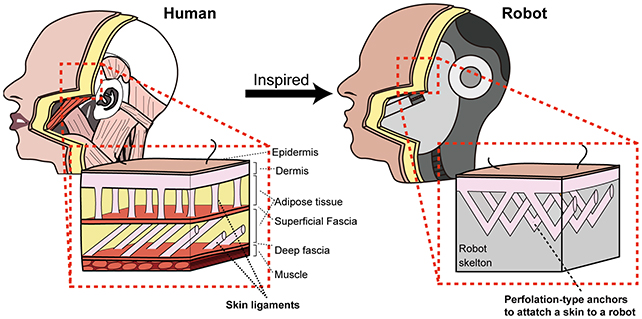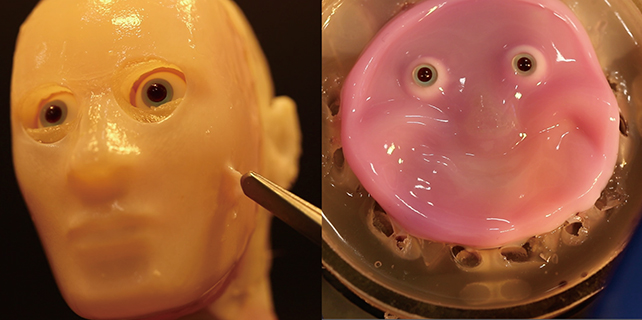Products You May Like
This terrifying monstrosity of a grin resulting from a new method to fix human skin tissue to robot ‘faces’, brings us a step closer to making them more like flesh and blood human beings.
There is a serious side to this: this kind of technology can help make robots more mobile and better able to heal any damage they sustain, as well as make it easier for sensors to be built into robotic structures.
That’s all well and good, and to be celebrated – but the example video clips that have just appeared alongside the new research from a team at the University of Tokyo in Japan should probably come with an age rating attached.
frameborder=”0″ allow=”accelerometer; autoplay; clipboard-write; encrypted-media; gyroscope; picture-in-picture; web-share” referrerpolicy=”strict-origin-when-cross-origin” allowfullscreen>
“By mimicking human skin-ligament structures and by using specially made V-shaped perforations in solid materials, we found a way to bind skin to complex structures,” says mechanical engineer Shoji Takeuchi.
“The natural flexibility of the skin and the strong method of adhesion mean the skin can move with the mechanical components of the robot without tearing or peeling away.”
Attaching skin tissue to solid surfaces isn’t easy – previous approaches included using miniature hooks – though these didn’t work well on curved surfaces, and could limit the possible motion of the robot.
frameborder=”0″ allow=”accelerometer; autoplay; clipboard-write; encrypted-media; gyroscope; picture-in-picture; web-share” referrerpolicy=”strict-origin-when-cross-origin” allowfullscreen>
Here, the team used a custom-made collagen gel, including cells grown from human skin, as the glue between tissue and robot.
Mimicking the attachment method of our own skin, the researchers engineered small perforations in the solid surface below so that the skin could stick to it even as the robot face shifted and changed shape.
The researchers cite self-healing as one of the big advantages of this new approach: the cyborgs of the future should be able to automatically repair their skin tissue in a similar way to humans, though the tech still has a long way to go to reach that stage.

“Manipulating soft, wet biological tissues during the development process is much harder than people outside the field might think,” says Takeuchi. “For instance, if sterility is not maintained, bacteria can enter and the tissue will die.”
“However, now that we can do this, living skin can bring a range of new abilities to robots.”
The team suggests their new approach could help with research into skin aging, cosmetics, and plastic surgery – and if nothing else, they could probably sell the tech to a movie studio to inspire a new horror franchise.

Joking aside, it brings life-like humanoid robots another step closer – and the thinking is that by adopting some of our best characteristics, these machines can end up being more durable and more helpful.
“In this study, we managed to replicate human appearance to some extent by creating a face with the same surface material and structure as humans,” says Takeuchi.
“Creating robots that can heal themselves, sense their environment more accurately and perform tasks with human-like dexterity is incredibly motivating.”
The research has been published in Cell Reports Physical Science.
